ANG
-
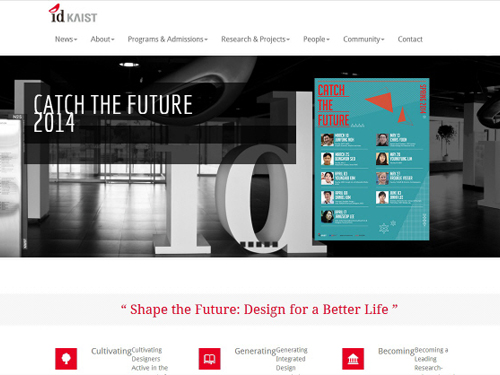 The Website of the KAIST Industrial Design Department Receives a Design Award
The 10th QS-Apple Higher Education Conference and Exhibition took place on November 11-13, 2014 in Taipei, Taiwan. The conference was hosted by Quacquarelli Symonds, a British company specializing in education, which publishes annually its world university rankings. Apple stands for Asia Pacific Professional Leaders in Education.
The QS-Apple conference supports the internationalization of Asia Pacific universities by providing opportunities for networking, exchanging best practices, and discussing recent developments in higher education. During the conference, the organizers presented the Creative Awards for best international education promotional designs in four categories: Website Pages, Video, Print Advertisement, and International Student Recruitment Brochures.
KAIST’s Industrial Design Department received the Best Website Pages Award for their website in recognition of high levels of user convenience and satisfaction as well as English language services. A total of 39 universities in the Asia and Pacific region competed in this category, and Nanyang Technological University in Singapore came in second place, followed by Hong Kong Baptist University in third.
2014.11.13 View 9985
The Website of the KAIST Industrial Design Department Receives a Design Award
The 10th QS-Apple Higher Education Conference and Exhibition took place on November 11-13, 2014 in Taipei, Taiwan. The conference was hosted by Quacquarelli Symonds, a British company specializing in education, which publishes annually its world university rankings. Apple stands for Asia Pacific Professional Leaders in Education.
The QS-Apple conference supports the internationalization of Asia Pacific universities by providing opportunities for networking, exchanging best practices, and discussing recent developments in higher education. During the conference, the organizers presented the Creative Awards for best international education promotional designs in four categories: Website Pages, Video, Print Advertisement, and International Student Recruitment Brochures.
KAIST’s Industrial Design Department received the Best Website Pages Award for their website in recognition of high levels of user convenience and satisfaction as well as English language services. A total of 39 universities in the Asia and Pacific region competed in this category, and Nanyang Technological University in Singapore came in second place, followed by Hong Kong Baptist University in third.
2014.11.13 View 9985 -
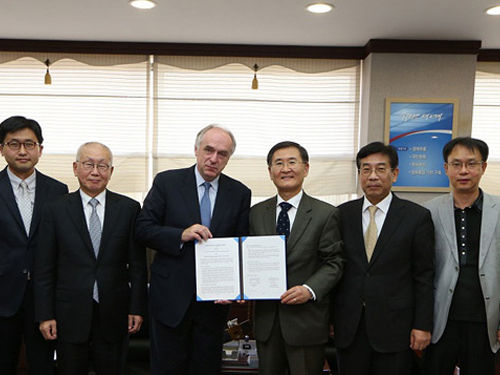 KAIST and the International Institute for Applied Systems Analysis Agree to Cooperate
KAIST signed a cooperation agreement with the International Institute for Applied Systems Analysis (IIASA) on October 29, 2014 at the president’s office.
Established in 1972 and based in Austria as a non-governmental research organization, IIASA is an international scientific institute that conducts policy-oriented research into global problems such as climate change, energy security, or population aging. IIASA examines such issues and devises strategies for cooperative action unconstrained by political and national self-interest.
Dr. Pavel Kabat, the Director General and CEO of IIASA, headed a delegation that visited KAIST to attend the signing ceremony of the agreement. He said, “KAIST has been known as a leading research university, and its strength in the development of green technology and environmental policy will benefit our institution. In particular, we expect to see vibrant exchanges of knowledge and researchers with the Graduate School of Green Growth (GSGG) and the Graduate School of EEWS (energy, environment, water, and sustainability) at KAIST.”
The two organizations will implement joint research projects in the diffusion analysis of green technology, the development and improvement of evaluation models to integrate economy, energy, and environment, the development of an analysis system for water resources, and the establishment of academic workshops and conferences.
The Dean of GSGG, Professor Jae-Kyu Lee said, “IIASA is a well-respected international organization with accumulated knowledge about analysis and prediction techniques. With this agreement, we hope that KAIST will intensify its research capacity in environmental science and lead education and research in green growth and environmental technology.”
The picture below shows Dr. Pavel Kabat, the Director General and CEO of IIASA, on the left and President Steve Kang of KAIST on the right holding the signed agreement with professors from GSGG and EEWS Graduate School including Professor Jae-Kyu Lee, to the right of President Kang.
2014.11.05 View 11624
KAIST and the International Institute for Applied Systems Analysis Agree to Cooperate
KAIST signed a cooperation agreement with the International Institute for Applied Systems Analysis (IIASA) on October 29, 2014 at the president’s office.
Established in 1972 and based in Austria as a non-governmental research organization, IIASA is an international scientific institute that conducts policy-oriented research into global problems such as climate change, energy security, or population aging. IIASA examines such issues and devises strategies for cooperative action unconstrained by political and national self-interest.
Dr. Pavel Kabat, the Director General and CEO of IIASA, headed a delegation that visited KAIST to attend the signing ceremony of the agreement. He said, “KAIST has been known as a leading research university, and its strength in the development of green technology and environmental policy will benefit our institution. In particular, we expect to see vibrant exchanges of knowledge and researchers with the Graduate School of Green Growth (GSGG) and the Graduate School of EEWS (energy, environment, water, and sustainability) at KAIST.”
The two organizations will implement joint research projects in the diffusion analysis of green technology, the development and improvement of evaluation models to integrate economy, energy, and environment, the development of an analysis system for water resources, and the establishment of academic workshops and conferences.
The Dean of GSGG, Professor Jae-Kyu Lee said, “IIASA is a well-respected international organization with accumulated knowledge about analysis and prediction techniques. With this agreement, we hope that KAIST will intensify its research capacity in environmental science and lead education and research in green growth and environmental technology.”
The picture below shows Dr. Pavel Kabat, the Director General and CEO of IIASA, on the left and President Steve Kang of KAIST on the right holding the signed agreement with professors from GSGG and EEWS Graduate School including Professor Jae-Kyu Lee, to the right of President Kang.
2014.11.05 View 11624 -
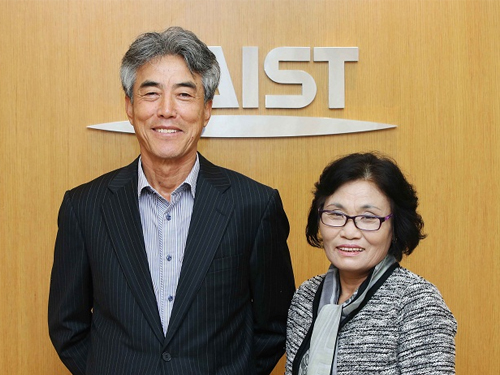 Parents of Alumni Donates to KAIST
Parents of KAIST alumni donated a scholarship of USD 4,800 to the university. A donation ceremony took place at the president’s office on October 21, 2014.
Two sons and the daughter-in-law of Ki-Hong Oh (husband) and Soon-Yi Kim (wife) studied at KAIST. Hwan-Hee Oh and Hwan-Yup Oh graduated with Master’s degrees in Mechanical Engineering in 2005 and 2009, respectively. Jung-Im Min received a Ph.D. in Mechanical Engineering in 2005.
Oh and Kim, who are orange growers in Jeju Island, Korea, said, “We have always appreciated the generous support our children received from KAIST and thought for many years about ways to make a contribution to the development of the university. Although this is a small amount, we are pleased to express our appreciation to KAIST.”
The couple hope that their donation will inspire others in Korea to follow suit and added, “Just like many of the great universities in the west which are supported through donations made by their alumni and people from all walks of life, we would like to see Korean universities also benefit from such a culture and practice.”
President Steve Kang expressed his gratitude to the couple and said, “KAIST will cherish your philanthropic good deeds, and the scholarship will be used to support students as you wish.”
2014.10.22 View 9567
Parents of Alumni Donates to KAIST
Parents of KAIST alumni donated a scholarship of USD 4,800 to the university. A donation ceremony took place at the president’s office on October 21, 2014.
Two sons and the daughter-in-law of Ki-Hong Oh (husband) and Soon-Yi Kim (wife) studied at KAIST. Hwan-Hee Oh and Hwan-Yup Oh graduated with Master’s degrees in Mechanical Engineering in 2005 and 2009, respectively. Jung-Im Min received a Ph.D. in Mechanical Engineering in 2005.
Oh and Kim, who are orange growers in Jeju Island, Korea, said, “We have always appreciated the generous support our children received from KAIST and thought for many years about ways to make a contribution to the development of the university. Although this is a small amount, we are pleased to express our appreciation to KAIST.”
The couple hope that their donation will inspire others in Korea to follow suit and added, “Just like many of the great universities in the west which are supported through donations made by their alumni and people from all walks of life, we would like to see Korean universities also benefit from such a culture and practice.”
President Steve Kang expressed his gratitude to the couple and said, “KAIST will cherish your philanthropic good deeds, and the scholarship will be used to support students as you wish.”
2014.10.22 View 9567 -
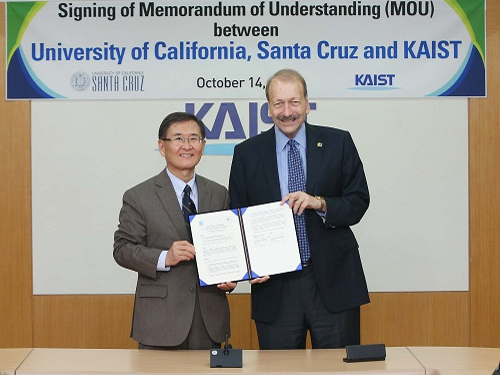 KAIST and University of California, Santa Cruz, Agree to Cooperate
KAIST and the University of California in Santa Cruz signed a memorandum of understanding (MOU) at the KAIST campus on October 14, 2014.
The two institutions agreed to cooperate in the following four areas:
- Research collaboration in genomics and biology
- Academic exchanges in engineering and information communication technology
- Student and faculty exchange programs
- Joint academic workshops and seminars
Following the MOU signing ceremony, Dr. George Blumenthal, the Chancellor of UC Santa Cruz, held a special seminar for KAIST students and faculty, during which he shared some of the success stories made through UC Santa Cruz’s close cooperation with companies in Silicon Valley.
President Steve Kang of KAIST praised the MOU saying, “KAIST and UC Santa Cruz have top-notch research professionals, and the MOU will reinforce their research capability. We hope that the two universities will carry out many research projects that bring significant impact on the world.”
UC Santa Cruz was established in 1965 as a public research university committed to undergraduate education. The university has a total student population of 16,000 (15,375 undergraduates and 1,378 graduates). Offering 60 undergraduate majors, UC Santa Cruz's faculty includes six recipients of Pulitzer Prizes and five MacArthur Genius Awards. The university was ranked the 2nd in the world for research influence in 2012-2013 Times Higher Education rankings.
2014.10.15 View 9130
KAIST and University of California, Santa Cruz, Agree to Cooperate
KAIST and the University of California in Santa Cruz signed a memorandum of understanding (MOU) at the KAIST campus on October 14, 2014.
The two institutions agreed to cooperate in the following four areas:
- Research collaboration in genomics and biology
- Academic exchanges in engineering and information communication technology
- Student and faculty exchange programs
- Joint academic workshops and seminars
Following the MOU signing ceremony, Dr. George Blumenthal, the Chancellor of UC Santa Cruz, held a special seminar for KAIST students and faculty, during which he shared some of the success stories made through UC Santa Cruz’s close cooperation with companies in Silicon Valley.
President Steve Kang of KAIST praised the MOU saying, “KAIST and UC Santa Cruz have top-notch research professionals, and the MOU will reinforce their research capability. We hope that the two universities will carry out many research projects that bring significant impact on the world.”
UC Santa Cruz was established in 1965 as a public research university committed to undergraduate education. The university has a total student population of 16,000 (15,375 undergraduates and 1,378 graduates). Offering 60 undergraduate majors, UC Santa Cruz's faculty includes six recipients of Pulitzer Prizes and five MacArthur Genius Awards. The university was ranked the 2nd in the world for research influence in 2012-2013 Times Higher Education rankings.
2014.10.15 View 9130 -
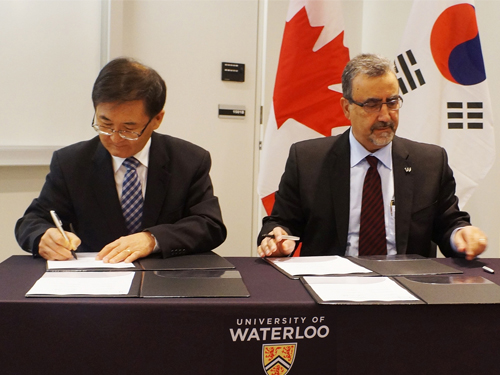 KAIST and University of Waterloo in Canada Agree to Enhance Cooperation
KAIST and the University of Waterloo, Canada, signed a memorandum of understanding (MOU) to explore collaboration in education and research in areas such as computer science, electrical engineering, chemical engineering, quantum computing, and nanotechnology. The two universities also agreed to expand their cooperation in entrepreneurship, technology transfer, and startup support programs. The signing ceremony took place at the University of Waterloo (UW) in Ontario, Canada, on September 22, 2014.
Feridun Hamdullahpur, president and vice-chancellor of UW, noted that “KAIST and the University of Waterloo have so much in common. Both institutions pursue excellence in teaching and research, attract some of the highest quality students and faculty alike, and seek out innovation that has the potential to change the world.”
President Steve Kang said, “The University of Waterloo has been leading the co-operative education field, offering valuable opportunities to young students to receive classroom-based education with practical work experience. This has been an important approach in higher education, and perhaps more so in this age when technological innovations create new values for social advancement and new opportunities for better growth. I hope that through the collaboration, KAIST and the University of Waterloo will produce research outcomes with global recognition.”
The University of Waterloo, located at the heart of Canada’s technology hub, has become one of the nation’s leading comprehensive universities in just half a century. The university is home to the world’s largest post-secondary co-operative education program, encouraging enterprising partnerships in learning and research.
The picture shows the signing of the MOU by President Steve Kang (right) and President and Vice-chancellor Feridun Hamdullahpur (left).
2014.09.26 View 8835
KAIST and University of Waterloo in Canada Agree to Enhance Cooperation
KAIST and the University of Waterloo, Canada, signed a memorandum of understanding (MOU) to explore collaboration in education and research in areas such as computer science, electrical engineering, chemical engineering, quantum computing, and nanotechnology. The two universities also agreed to expand their cooperation in entrepreneurship, technology transfer, and startup support programs. The signing ceremony took place at the University of Waterloo (UW) in Ontario, Canada, on September 22, 2014.
Feridun Hamdullahpur, president and vice-chancellor of UW, noted that “KAIST and the University of Waterloo have so much in common. Both institutions pursue excellence in teaching and research, attract some of the highest quality students and faculty alike, and seek out innovation that has the potential to change the world.”
President Steve Kang said, “The University of Waterloo has been leading the co-operative education field, offering valuable opportunities to young students to receive classroom-based education with practical work experience. This has been an important approach in higher education, and perhaps more so in this age when technological innovations create new values for social advancement and new opportunities for better growth. I hope that through the collaboration, KAIST and the University of Waterloo will produce research outcomes with global recognition.”
The University of Waterloo, located at the heart of Canada’s technology hub, has become one of the nation’s leading comprehensive universities in just half a century. The university is home to the world’s largest post-secondary co-operative education program, encouraging enterprising partnerships in learning and research.
The picture shows the signing of the MOU by President Steve Kang (right) and President and Vice-chancellor Feridun Hamdullahpur (left).
2014.09.26 View 8835 -
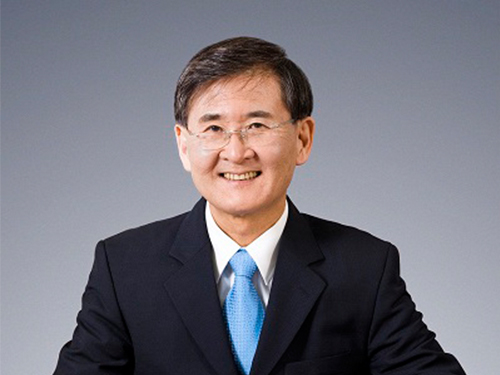 President Steve Kang of KAIST Attends the 2014 Summer Davos Forum in Tianjin, China
President Steve Kang of KAIST will attend the 2014 Annual Meeting of the New Champions, the World Economic Forum (WEF), to be held on September 10-12, 2014 in Tianjin, China.
KAIST holds its own IdeasLab session on nanotechnology on September 12, 2014.
On September 10, 2014, President Steve Kang will participate in a private session hosted by the Global University Leaders Forum (GULF) community at WEF as a panelist.
In addition to President Kang, eight presidents from top global universities such as the National University of Singapore, Peking University, ETH Zurich (Swiss Federal Institute of Technology), University of Tokyo, and Carnegie Mellon University will join the panel discussion under the topic, “Increasing the Translational Impact of University Research.” Specifically, the presidents will address issues related to the importance of university-led technology transfer in Asia, key strategies and goals for technology transfer, and implementation approaches taken by each university to promote technology transfer from university to industry.
President Kang was invited to this GULF session, the only attendant from Korean universities, in recognition of his long time experience and expertise in education and research.
In 2006, WEF created the GULF, a small community of the presidents of top universities in the world, aiming to offer an open platform for high-level dialogues on issues of higher education and research with other sectors, as well as to foster collaboration between universities in areas of significance for global policy.
As of 2014, a total of 25 globally leading universities, including Harvard University, University of Cambridge, and Massachusetts Institute of Technology, are GULF members. KAIST, which joined the club this year, is the only Korean university.
The 2014 Annual Meeting of the New Champions, also known as the Summer Davos Forum, hosts numerous sessions under the theme of “Creating Value through Innovation.” At the Forum, a total of ten IdeasLab sessions will be hosted. KAIST was invited to run its own IdeasLab on nanotechnology on September 12, 2014.
Together with President Kang, Professors Sang Ouk Kim and Keon Jae Lee from the Department of Materials Science Engineering, KAIST, and Professors Sang Yup Lee and Hyunjoo Lee from the Department of Chemical and Biomolecular Engineering, KAIST, will present their own speeches on the topic entitled “From diagnostics to materials, how is nanotechnology changing lives?”
President Kang will give the opening speech at the KAIST IdeasLab.
He said that an invitation from WEF to join the IdeasLab spoke well for KAIST:
“KAIST is the first and the only Korean university ever invited to run its own IdeasLab at the World Economic Forum. The IdeasLab is an expert group meeting, conducted only by the world’s most prestigious universities and research institutes. At the IdeasLab sessions, global leaders from different sectors identify major issues facing higher education and humanity and explore solutions through science and technology innovation. Holding our own IdeasLab on one of our strongest fields, nanotechnology, is indeed an excellent opportunity for KAIST to show its strength in academic and research excellence on the global stage.”
2014.09.08 View 15929
President Steve Kang of KAIST Attends the 2014 Summer Davos Forum in Tianjin, China
President Steve Kang of KAIST will attend the 2014 Annual Meeting of the New Champions, the World Economic Forum (WEF), to be held on September 10-12, 2014 in Tianjin, China.
KAIST holds its own IdeasLab session on nanotechnology on September 12, 2014.
On September 10, 2014, President Steve Kang will participate in a private session hosted by the Global University Leaders Forum (GULF) community at WEF as a panelist.
In addition to President Kang, eight presidents from top global universities such as the National University of Singapore, Peking University, ETH Zurich (Swiss Federal Institute of Technology), University of Tokyo, and Carnegie Mellon University will join the panel discussion under the topic, “Increasing the Translational Impact of University Research.” Specifically, the presidents will address issues related to the importance of university-led technology transfer in Asia, key strategies and goals for technology transfer, and implementation approaches taken by each university to promote technology transfer from university to industry.
President Kang was invited to this GULF session, the only attendant from Korean universities, in recognition of his long time experience and expertise in education and research.
In 2006, WEF created the GULF, a small community of the presidents of top universities in the world, aiming to offer an open platform for high-level dialogues on issues of higher education and research with other sectors, as well as to foster collaboration between universities in areas of significance for global policy.
As of 2014, a total of 25 globally leading universities, including Harvard University, University of Cambridge, and Massachusetts Institute of Technology, are GULF members. KAIST, which joined the club this year, is the only Korean university.
The 2014 Annual Meeting of the New Champions, also known as the Summer Davos Forum, hosts numerous sessions under the theme of “Creating Value through Innovation.” At the Forum, a total of ten IdeasLab sessions will be hosted. KAIST was invited to run its own IdeasLab on nanotechnology on September 12, 2014.
Together with President Kang, Professors Sang Ouk Kim and Keon Jae Lee from the Department of Materials Science Engineering, KAIST, and Professors Sang Yup Lee and Hyunjoo Lee from the Department of Chemical and Biomolecular Engineering, KAIST, will present their own speeches on the topic entitled “From diagnostics to materials, how is nanotechnology changing lives?”
President Kang will give the opening speech at the KAIST IdeasLab.
He said that an invitation from WEF to join the IdeasLab spoke well for KAIST:
“KAIST is the first and the only Korean university ever invited to run its own IdeasLab at the World Economic Forum. The IdeasLab is an expert group meeting, conducted only by the world’s most prestigious universities and research institutes. At the IdeasLab sessions, global leaders from different sectors identify major issues facing higher education and humanity and explore solutions through science and technology innovation. Holding our own IdeasLab on one of our strongest fields, nanotechnology, is indeed an excellent opportunity for KAIST to show its strength in academic and research excellence on the global stage.”
2014.09.08 View 15929 -
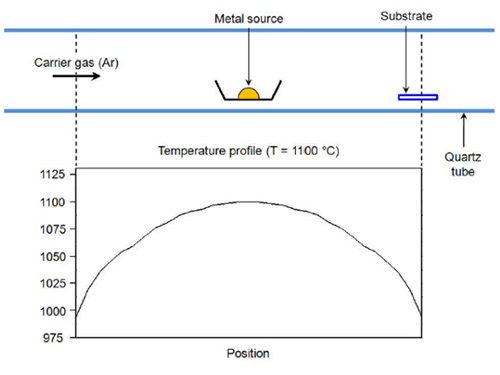 Development of Gold Nanowire Probe Needle with an Increased Sensitivity
Professor Bongsoo Kim
The newly developed nano-probe needle’s thickness estimates only at 0.1 micrometers with an increased 1,000-fold sensitivity and spatial resolution of 1mm.
Professor Bongsoo Kim and his research team from the Department of Chemistry, KASIT, including the first author, Dr. Mijeong Kang, succeeded in measuring nerve signals of a mouse using the world’s thinnest nano-probe needle made of single-crystal gold nanowires.
The newly developed nano-probe needle possesses the thickness of 100 nanometers (nm), which shows 1,000 times more sensitivity than the conventional nerve probe needles, as well as accurately measures nerve signals with an extremely fine resolution of less than 1mm. Unlike the existing probe needles that cause neural tissues to be damaged during insertion, the new nano-probe needle minimizes the damage and thus can detect large nerve signals.
The brain neural probe, which collects and analyzes electrical nerve signals generated in the brain, is the most essential element in brain research. A neural probe should minimize tissue damages, but needs to possess a good electrical sensitivity.
The researchers first applied heat on the gold, which is the necessary material for a probe, until it turned to a vapor phase. Then, the gold evaporation slug was transported to a colder board and left to form single-crystal gold nano structures by condensation. Because the new gold nanowire, produced by using this principle, is a flawless single crystal structure, it shows strong and flexible properties.
Professor Kim and his team applied the nano-probe needle into the brain of a mouse that has been administered a drug to induce epilepsy. They were able to find the exact area in the brain that triggers epilepsy. Furthermore, the researchers also detected neural signal changes in the brain of the mouse when it encountered the intrusion of a stranger mouse.
Professor Bongsoo Kim commented the meaning of his research:
“The new nano-probe needle is able to detect signals from a single nerve cell with high sensitivity while preserving the nerve cells intact. The probe needle will be useful for creating a precise three-dimensional brain map, as well as providing electrical treatment for brain diseases such as dementia and Parkinson's disease.”
This research results were published online in the August 12, 2014 edition of ACS Nano.
2014.09.06 View 7124
Development of Gold Nanowire Probe Needle with an Increased Sensitivity
Professor Bongsoo Kim
The newly developed nano-probe needle’s thickness estimates only at 0.1 micrometers with an increased 1,000-fold sensitivity and spatial resolution of 1mm.
Professor Bongsoo Kim and his research team from the Department of Chemistry, KASIT, including the first author, Dr. Mijeong Kang, succeeded in measuring nerve signals of a mouse using the world’s thinnest nano-probe needle made of single-crystal gold nanowires.
The newly developed nano-probe needle possesses the thickness of 100 nanometers (nm), which shows 1,000 times more sensitivity than the conventional nerve probe needles, as well as accurately measures nerve signals with an extremely fine resolution of less than 1mm. Unlike the existing probe needles that cause neural tissues to be damaged during insertion, the new nano-probe needle minimizes the damage and thus can detect large nerve signals.
The brain neural probe, which collects and analyzes electrical nerve signals generated in the brain, is the most essential element in brain research. A neural probe should minimize tissue damages, but needs to possess a good electrical sensitivity.
The researchers first applied heat on the gold, which is the necessary material for a probe, until it turned to a vapor phase. Then, the gold evaporation slug was transported to a colder board and left to form single-crystal gold nano structures by condensation. Because the new gold nanowire, produced by using this principle, is a flawless single crystal structure, it shows strong and flexible properties.
Professor Kim and his team applied the nano-probe needle into the brain of a mouse that has been administered a drug to induce epilepsy. They were able to find the exact area in the brain that triggers epilepsy. Furthermore, the researchers also detected neural signal changes in the brain of the mouse when it encountered the intrusion of a stranger mouse.
Professor Bongsoo Kim commented the meaning of his research:
“The new nano-probe needle is able to detect signals from a single nerve cell with high sensitivity while preserving the nerve cells intact. The probe needle will be useful for creating a precise three-dimensional brain map, as well as providing electrical treatment for brain diseases such as dementia and Parkinson's disease.”
This research results were published online in the August 12, 2014 edition of ACS Nano.
2014.09.06 View 7124 -
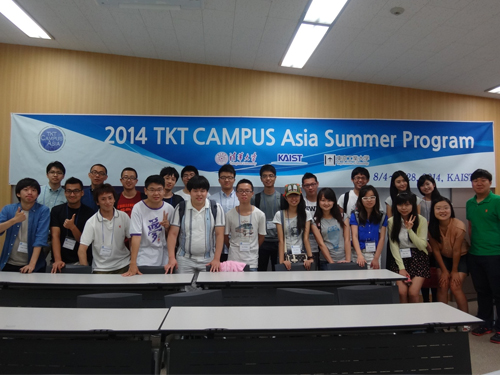 The 2014 CAMPUS Asia Summer Program
The CAMPUS Asia (Collective Action for Mobility Program of University Students in Asia) is an academic exchange program originally proposed at the third presidential meeting of three nations, Korea, China, and Japan, which was held in May 2010 on Jeju Island.
Under the proposal, three science and technology universities, Tsinghua University (China), KAIST (Korea), and Tokyo Institute of Technology (Japan), created a program in 2012 for academic and research collaboration, TKT CAMPUS Asia. Since then, each university has been hosting an exchange program in rotation.
The 2014 summer program of TKT CAMPUS Asia was held from August 4th through 28th at KAIST. A total of 13 professors from the departments of chemical engineering, mechanical engineering, and life science, as well as 25 students participated. Under the summer program, three courses in biotechnology, mechanical engineering, and Korean language were offered. The universities gave credits for all courses.
As part of TKT CAMPUS Asia, KAIST has also operated a semester study abroad and foreign exchange program and will begin a joint degree program by 2015.
Professor Jung Kim of the Department of Mechanical Engineering at KAIST said,
“Just as the Erasmus Program (European Community Action Scheme for the Mobility of University Students) contributed to the foundation of the European Union, we hope that the CAMPUS Asia will serve a similar goal for a greater Asia.”
2014.09.03 View 7224
The 2014 CAMPUS Asia Summer Program
The CAMPUS Asia (Collective Action for Mobility Program of University Students in Asia) is an academic exchange program originally proposed at the third presidential meeting of three nations, Korea, China, and Japan, which was held in May 2010 on Jeju Island.
Under the proposal, three science and technology universities, Tsinghua University (China), KAIST (Korea), and Tokyo Institute of Technology (Japan), created a program in 2012 for academic and research collaboration, TKT CAMPUS Asia. Since then, each university has been hosting an exchange program in rotation.
The 2014 summer program of TKT CAMPUS Asia was held from August 4th through 28th at KAIST. A total of 13 professors from the departments of chemical engineering, mechanical engineering, and life science, as well as 25 students participated. Under the summer program, three courses in biotechnology, mechanical engineering, and Korean language were offered. The universities gave credits for all courses.
As part of TKT CAMPUS Asia, KAIST has also operated a semester study abroad and foreign exchange program and will begin a joint degree program by 2015.
Professor Jung Kim of the Department of Mechanical Engineering at KAIST said,
“Just as the Erasmus Program (European Community Action Scheme for the Mobility of University Students) contributed to the foundation of the European Union, we hope that the CAMPUS Asia will serve a similar goal for a greater Asia.”
2014.09.03 View 7224 -
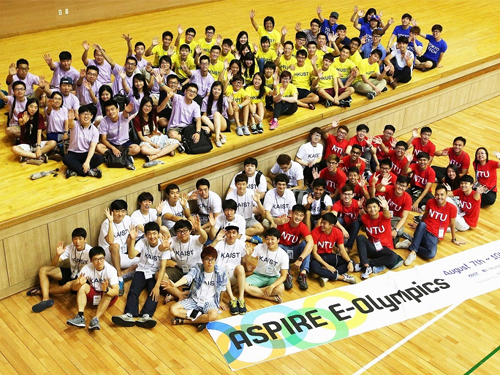 ASPIRE League 2014: E-Olympics among Five Asian Universities
About 150 undergraduate students from five leading science and technology (S&T) universities in Asia met at the KAIST campus to attend the E-Olympics on August 7-9, 2014.
The E-Olympics began as a student exchange conference held under the Asian Science and Technology Pioneering Institutes of Research and Education (ASPIRE) League, which offers a variety of events, such as workshops, sports matches, lab visits, special lectures, and art performances, to promote academic and research collaborations and cultural sharing between the students of the league member universities.
Founded in 2009, the ASPIRE League is a university consortium consisted of five top S&T universities in Asia: KAIST in Korea, the Hong Kong University of Science and Technology (HKUST) and Tsinghua University in China, Nanyang Technological University (NTU) in Singapore, and Tokyo Institute of Technology (Tokyo Tech) in Japan. The ASPIRE League aims to provide a knowledge and technology hub for innovation in Asia through the advancement of science and technology and the development of human resources.
Since its start, the ASPIRE League has been holding an annual conference with programs for research collaboration, student exchange, educational cooperation, and satellite laboratories among professors, senior managers, and students of the member universities. This year, however, the consortium decided to dedicate the conference to students by holding the E-Olympics.
Each university sent 30 students to KAIST for the participation of the E-Olympics. For three days, participating students engaged in discussions and presentations at academic workshops; held athletic games including a relay race, basketball, and a rowing race; and toured a few KAIST laboratories, among them: the E-mobility Research Center, the Bio-imaging and Cell Signaling Research Center, the Mechatronics Systems and Control Center, and the Center of Field Robotics for Innovation, Exploration and Defense.
The students also attended a music concert performed by a KAIST student club and a lecture entitled “Entrepreneurship through Global Networking” that emphasized the importance of personnel networking in transferring technological innovation into business opportunities.
Chang-Dong Yoo, the Dean of the International Office at KAIST, said, “The E-Olympics will offer students from top science and technology universities in Asia opportunities to interact with each other on a more personal level. I hope that through many of the E-Olympics programs, the students will learn about each other’s culture and academic strength and develop a sense of community to create a “New Asia” by working together.”
2014.08.11 View 14347
ASPIRE League 2014: E-Olympics among Five Asian Universities
About 150 undergraduate students from five leading science and technology (S&T) universities in Asia met at the KAIST campus to attend the E-Olympics on August 7-9, 2014.
The E-Olympics began as a student exchange conference held under the Asian Science and Technology Pioneering Institutes of Research and Education (ASPIRE) League, which offers a variety of events, such as workshops, sports matches, lab visits, special lectures, and art performances, to promote academic and research collaborations and cultural sharing between the students of the league member universities.
Founded in 2009, the ASPIRE League is a university consortium consisted of five top S&T universities in Asia: KAIST in Korea, the Hong Kong University of Science and Technology (HKUST) and Tsinghua University in China, Nanyang Technological University (NTU) in Singapore, and Tokyo Institute of Technology (Tokyo Tech) in Japan. The ASPIRE League aims to provide a knowledge and technology hub for innovation in Asia through the advancement of science and technology and the development of human resources.
Since its start, the ASPIRE League has been holding an annual conference with programs for research collaboration, student exchange, educational cooperation, and satellite laboratories among professors, senior managers, and students of the member universities. This year, however, the consortium decided to dedicate the conference to students by holding the E-Olympics.
Each university sent 30 students to KAIST for the participation of the E-Olympics. For three days, participating students engaged in discussions and presentations at academic workshops; held athletic games including a relay race, basketball, and a rowing race; and toured a few KAIST laboratories, among them: the E-mobility Research Center, the Bio-imaging and Cell Signaling Research Center, the Mechatronics Systems and Control Center, and the Center of Field Robotics for Innovation, Exploration and Defense.
The students also attended a music concert performed by a KAIST student club and a lecture entitled “Entrepreneurship through Global Networking” that emphasized the importance of personnel networking in transferring technological innovation into business opportunities.
Chang-Dong Yoo, the Dean of the International Office at KAIST, said, “The E-Olympics will offer students from top science and technology universities in Asia opportunities to interact with each other on a more personal level. I hope that through many of the E-Olympics programs, the students will learn about each other’s culture and academic strength and develop a sense of community to create a “New Asia” by working together.”
2014.08.11 View 14347 -
 2014 NEREC Conference on Nuclear Nonproliferation: July 31-August 1, 2014, Seoul
The Nonproliferation Education and Research Center (NEREC) at KAIST hosted an international conference on nuclear nonproliferation on July 31-August 1, 2014 in Seoul. The Ministry of Science, ICT and Future Planning, the Korean Nuclear Safety and Security Commission, and the Korea Nuclear Policy Society (KNPS) sponsored the event.
Over one hundred experts and "thought leaders" in nuclear security and nonproliferation attended the conference and discussed issues related to the nonproliferation of nuclear weapons, the role of scientific community in mitigating nuclear threat and promoting the peaceful use of nuclear power, and nuclear disarmament policy.
Keynote speakers were: Steven E. Miller, Director of International Security Program at Belfer Center for Science and International Affairs, Harvard University; Scott D. Sagan, Senior Fellow of the Center for International Security and Cooperation, Freeman Spogli Institute for International Studies, Stanford University; Mark Fitzpatrick, Director of the Nonproliferation and Disarmament Programme, International Institute for Strategic Studies; Sang-Hyun Lee, Director of Security Strategy, Sejong Institute; and Man-Sung Yim, Professor of Nuclear and Quantum Engineering, KAIST.
At the conference, Professor Yim, Director of KAIST NEREC said, “Korea has grown to become a key player in the development of commercial nuclear energy over the past decades. We hope that our conference encourages Korea to be more involved in the efforts of the international community to enhance the global nonproliferation regime.”
2014.08.05 View 16009
2014 NEREC Conference on Nuclear Nonproliferation: July 31-August 1, 2014, Seoul
The Nonproliferation Education and Research Center (NEREC) at KAIST hosted an international conference on nuclear nonproliferation on July 31-August 1, 2014 in Seoul. The Ministry of Science, ICT and Future Planning, the Korean Nuclear Safety and Security Commission, and the Korea Nuclear Policy Society (KNPS) sponsored the event.
Over one hundred experts and "thought leaders" in nuclear security and nonproliferation attended the conference and discussed issues related to the nonproliferation of nuclear weapons, the role of scientific community in mitigating nuclear threat and promoting the peaceful use of nuclear power, and nuclear disarmament policy.
Keynote speakers were: Steven E. Miller, Director of International Security Program at Belfer Center for Science and International Affairs, Harvard University; Scott D. Sagan, Senior Fellow of the Center for International Security and Cooperation, Freeman Spogli Institute for International Studies, Stanford University; Mark Fitzpatrick, Director of the Nonproliferation and Disarmament Programme, International Institute for Strategic Studies; Sang-Hyun Lee, Director of Security Strategy, Sejong Institute; and Man-Sung Yim, Professor of Nuclear and Quantum Engineering, KAIST.
At the conference, Professor Yim, Director of KAIST NEREC said, “Korea has grown to become a key player in the development of commercial nuclear energy over the past decades. We hope that our conference encourages Korea to be more involved in the efforts of the international community to enhance the global nonproliferation regime.”
2014.08.05 View 16009 -
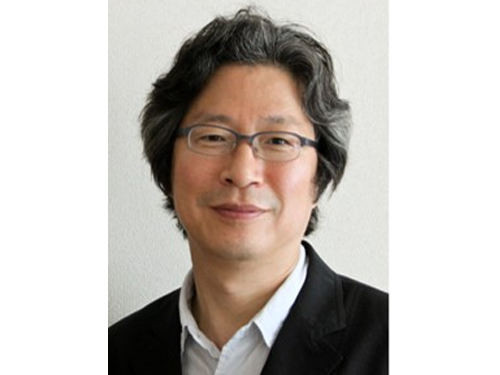 The Journal of Clinical Investigation: Researchers Uncover the Secret Lymphatic Identity of the Schlemm's Canal
The Journal of Clinical Investigation (JCI), a peer-reviewed, top-tier medical journal published by the American Society for Clinical Investigation, carried a commentary entitled “Schlemm’s Canal: More Than Meets the Eye, Lymphatics in Disguise” in the July 25, 2014 issue.
In the commentary, the authors compared a research paper (“Lymphatic regular PROX1 determines Schlemm’s canal integrity and identity”) by Professor Gou-Young Koh of the Graduate School of Medical Science and Engineering at KAIST with research work from the University of Helsinki (article entitled “The Schlemm’s canal is a VEGF-C/VEGFR-3 responsive lymphatic-like vessel”).
The JCI released a press statement dated July 25, 2014 on its commentary. It mentioned that glaucoma, one of the leading causes of blindness worldwide, elevates eye pressure owing to poor drainage of aqueous humor. A specialized structure called “Schlemm’s canal” funnels aqueous humor from the eye back into circulation, which is critical to prevent pressure buildup in the eye. The article discussed the role of Schlemm’s canal in the context of lymphatic vascular characteristics by reviewing two research group’s papers back-to-back.
For the full text of the press release, please visit the link below:
Press Release from the Journal of Clinical Investigation, July 25, 2014
“Researchers uncover the secret lymphatic identity of the Schlemm’s canal”
http://www.eurekalert.org/pub_releases/2014-07/joci-rut072414.php
2014.07.28 View 9215
The Journal of Clinical Investigation: Researchers Uncover the Secret Lymphatic Identity of the Schlemm's Canal
The Journal of Clinical Investigation (JCI), a peer-reviewed, top-tier medical journal published by the American Society for Clinical Investigation, carried a commentary entitled “Schlemm’s Canal: More Than Meets the Eye, Lymphatics in Disguise” in the July 25, 2014 issue.
In the commentary, the authors compared a research paper (“Lymphatic regular PROX1 determines Schlemm’s canal integrity and identity”) by Professor Gou-Young Koh of the Graduate School of Medical Science and Engineering at KAIST with research work from the University of Helsinki (article entitled “The Schlemm’s canal is a VEGF-C/VEGFR-3 responsive lymphatic-like vessel”).
The JCI released a press statement dated July 25, 2014 on its commentary. It mentioned that glaucoma, one of the leading causes of blindness worldwide, elevates eye pressure owing to poor drainage of aqueous humor. A specialized structure called “Schlemm’s canal” funnels aqueous humor from the eye back into circulation, which is critical to prevent pressure buildup in the eye. The article discussed the role of Schlemm’s canal in the context of lymphatic vascular characteristics by reviewing two research group’s papers back-to-back.
For the full text of the press release, please visit the link below:
Press Release from the Journal of Clinical Investigation, July 25, 2014
“Researchers uncover the secret lymphatic identity of the Schlemm’s canal”
http://www.eurekalert.org/pub_releases/2014-07/joci-rut072414.php
2014.07.28 View 9215 -
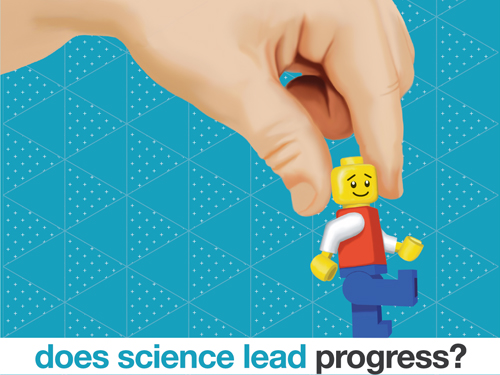 The ICISTS-KAIST International Conference from August 4-8, 2014 in KAIST Campus, Korea
"Does science lead progress?"
This thought-provoking question will be explored this summer with hundreds of university students gathered from all around the world at the campus of the Korea Advanced Institute of Science and Technology (KAIST), a leading science and technology university in Korea.
Established in 2005, the International Conference for Integration of Science, Technology and Society (ICISTS)-KAIST has been hosted every summer for Korean and international university students in Daejeon, Republic of Korea. The conference features distinguished speakers from academia, business, and public sectors and enables participants to exchange views, identify issues affecting science and society, and explore possible solutions.
The ICISTS-KAIST is the largest interdisciplinary conference in Asia. It is organized by undergraduate students of KAIST and promotes the idea of a science- and technology-integrated society through international cooperation of college students from diverse backgrounds. Last year alone, about 400 participants from 103 universities in 25 countries attended the conference.
Marking the 10th anniversary, the ICISTS-KAIST International Conference 2014 will scrutinize the fundamental aspect of scientific and technological progress versus social advancement under the theme of "Does Science Lead Progress?"
"We hope that the conference provides students with an interactive platform to look into some of the essential, yet easily neglected, questions such as the purpose of science and technology education in a broader context of social values," said Dong-Yeon Woo, President of Organizing Committee for the ICISTS-KAIST International Conference 2014.
Among keynote speakers are Langdon Winner, a professor of Science and Technology Studies at Rensselaer Polytechnic Institute, Stephen Hilgartner, an associate professor of Science and Technology Studies at Cornell University, and Steve Breyman, an associate professor of Science and Technology Studies at Rensselaer Polytechnic Institute.
Langdon Winner will speak about the fallacy of the public perception that technological innovation leads to social revolution (his presentation is entitled "The Myth of Innovation"). Stephen Hilgartner will present four aspects of the politics of vision in today's science and technology ("Science, Technology, and the Politics of Vision"), and Steve Breyman will talk about the origin of scientific deception, misrepresentation, and prevarication ("The Agnotology of Hydrofracking").
The conference lasts five days, beginning on August 4th through August 8th, 2014 at KAIST campus. For participation, regular online application opens until July 11, 2014 at http://www.icists.org.
2014.07.04 View 10609
The ICISTS-KAIST International Conference from August 4-8, 2014 in KAIST Campus, Korea
"Does science lead progress?"
This thought-provoking question will be explored this summer with hundreds of university students gathered from all around the world at the campus of the Korea Advanced Institute of Science and Technology (KAIST), a leading science and technology university in Korea.
Established in 2005, the International Conference for Integration of Science, Technology and Society (ICISTS)-KAIST has been hosted every summer for Korean and international university students in Daejeon, Republic of Korea. The conference features distinguished speakers from academia, business, and public sectors and enables participants to exchange views, identify issues affecting science and society, and explore possible solutions.
The ICISTS-KAIST is the largest interdisciplinary conference in Asia. It is organized by undergraduate students of KAIST and promotes the idea of a science- and technology-integrated society through international cooperation of college students from diverse backgrounds. Last year alone, about 400 participants from 103 universities in 25 countries attended the conference.
Marking the 10th anniversary, the ICISTS-KAIST International Conference 2014 will scrutinize the fundamental aspect of scientific and technological progress versus social advancement under the theme of "Does Science Lead Progress?"
"We hope that the conference provides students with an interactive platform to look into some of the essential, yet easily neglected, questions such as the purpose of science and technology education in a broader context of social values," said Dong-Yeon Woo, President of Organizing Committee for the ICISTS-KAIST International Conference 2014.
Among keynote speakers are Langdon Winner, a professor of Science and Technology Studies at Rensselaer Polytechnic Institute, Stephen Hilgartner, an associate professor of Science and Technology Studies at Cornell University, and Steve Breyman, an associate professor of Science and Technology Studies at Rensselaer Polytechnic Institute.
Langdon Winner will speak about the fallacy of the public perception that technological innovation leads to social revolution (his presentation is entitled "The Myth of Innovation"). Stephen Hilgartner will present four aspects of the politics of vision in today's science and technology ("Science, Technology, and the Politics of Vision"), and Steve Breyman will talk about the origin of scientific deception, misrepresentation, and prevarication ("The Agnotology of Hydrofracking").
The conference lasts five days, beginning on August 4th through August 8th, 2014 at KAIST campus. For participation, regular online application opens until July 11, 2014 at http://www.icists.org.
2014.07.04 View 10609